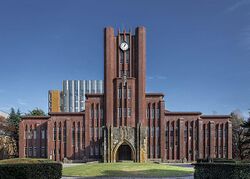Zhenia
Greater Eastern Union of Zhenia 大東陳國聯邦 대동진국연방 | |
|---|---|
| Motto: "자유, 민권, 민생." Liberty, Democracy and the Welfare of the People. | |
| Anthem: Spirit of Zhenia | |
 Location of Zhenia in the world in gold. | |
 A map of Zhenia in Northeast Asia. | |
| Capital and largest city | Donggyeong |
| Official languages | Zhenian |
| Other languages | |
| Ethnic groups (2019) |
|
| Demonym(s) | Zhenian |
| Government | Federal Semi-Presidential Republic (de facto) Unitary Semi-Presidential Republic (de jure) |
| Lee Saemin | |
• Premier | Kim Junghun |
| Legislature | Parliament of the Greater Eastern Union |
| Senate | |
| Federal Assembly | |
| Establishment | |
• as the Shindan dynasty | July 3, 1298 |
• as the Empire of Greater Wu | January 5, 1567 |
• as the Empire of Zhenia | August 3, 1868 |
| June 4, 1909 | |
• as current form | December 1, 1979 |
| Area | |
• | 6,391,077.1 km2 (2,467,608.7 sq mi) |
• Water (%) | 3.39% |
| Population | |
• 2019 estimate | 756.3 million |
• 2019 census | 756,236,689 |
| GDP (PPP) | 2019 estimate |
• Total | $21.351 trillion |
• Per capita | $28,233.1 |
| GDP (nominal) | 2019 estimate |
• Total | $20.526 trillion |
• Per capita | $27,140.2 |
| Gini (2019) | medium |
| HDI (2017) | very high |
| Currency | Zhenian Won (ZKW) |
| Time zone | UTC+7, +8, +9 (Zhenia Western Standard Time (ZWST), Zhenia Central Standard Time (ZCST), Zhenia Eastern Standard Time (ZEST)) |
| Date format | mm-dd-yyyy |
| Driving side | right |
| Calling code | +11 |
| Internet TLD | .zh/.zhen/.geu |
Zhenia (Classic Zhenian: 陳國, Modern Zhenian: 진국), formally known as the Greater Eastern Union of Zhenia (Classic Zhenian: 大東真國聯邦, Modern Zhenian: 대동진국연방), is a federal semi-presidential republic consisting of 28 provinces, 5 metropolitan municipalities (Jinhae, Changan, Shinhang, Bakhan and Ariul) and one capital district. Situated in East Tarsia and spanning across 6,391,077.1 km2 over both the mainland and the Danguk Peninsula, it is the third-largest in the world by territorial size, following the Northern Confederation and Florencia. It is bordered by numerous entities in the region and faces the North Zhenian Sea and East Zhenian Sea to its northeast and east.
Civilization emerged in both mainland Zhenia and the Danguk Peninsula by 2,000 BCE. The Liang Dynasty came to existence in central Zhenia around 1800 BCE, while the State of Danguk was founded around 2000 BCE. Since then, much of Zhenian history consisted of hereditary monarchies, or dynasties, and their expansion, fracture and replacement by other entities. In 322 BCE, the Zhen dynasty, led by Shen Lien, became the first dynasty to unify both the Danguk Peninsula and mainland Zhenia, assimilating mainland Zhenian cultural elements into those of the Danguk Peninsula and establishing the Zhenian identity over the centuries it existed. Mainland Zhenia and the Danguk Peninsula were ruled by separate entities following the Zhen's collapse in the 6th century, although numerous successive dynasties attempted reunification. The reunification arrived during the last stages of the Shindan dynasty, when Emperor Seongjo reformed the former backwater tributary state into a great power through leveraging the interests of Auroran powers and rapid industrialization with the cooperation of Husgratin and Zonnenbord. After a series of military campaigns, Shindan ultimately brought an end to the Empire of Greater Wu and reunified all of Zhenia into the Empire of Zhenia in 1868.
Zhenia's resurgence in the late 19th century resulted in the Shinzhen Movement, leading to numerous wars against existing Auroran colonial powers within its sphere of influence. Industrialization and initial victory against Aurorans resulted in the advent of militarism and ultra-nationalism, which intensified with the ultimate transition into the First and Second Republics respectively. Its victory in the First Great War confirmed its status as a global, expansionist military power. Zhenian causing and involvement in the Second Great War ended in Zhenian Surrender in 1948. In 1953, a military junta led by Kim Shimin was established through the Coup of 1953, with the regime ultimately propelling the nation's rapid economic development often referred to as the Miracle of the Jin River. The November Revolution of 1979 of 1979 brought an end to the Fourth Republic and resulted in the democratization of Zhenia and the subsequent declaration of the Fifth Republic. To this day, Zhenia remains a democratic republic.
As of 2019, Zhenia is both the largest economy in the world by nominal GDP at around $15.24 trillion and by GDP purchasing power parity (PPP) at $15.36 trillion, while it is also the largest exporter and second-largest importer of goods. It is a global leader in industrial and technological sectors, with its export-driven economy focusing on electronics, aerospace, automobiles, shipbuilding and robotics. It has the largest defense budget in the world at around $774 billion and has been a nuclear weapons state since 1959. In recent times, Zhenia has been characterized as a global great power, while estimates claim it will achieve superpower status by 2020.
Etymology
History
Main Article: History of Zhenia
Antiquity
Main Article: History of Ancient Zhenia
Mainland Zhenia
Main Article: History of Mainland Zhenia
The decline of the Zhen Dynasty in the 6th century was met with the advent of numerous smaller kingdoms scattered across the Zhenian mainland, hence initiating the era known as the Hundred States Era. Numerous kingdoms fought to claim the now-empty title of successor of the Zhen dynasty, most in vain. By 700, mainland Zhenia was reorganized into a standstill between two nations - the Kuan and Wei dynasties.
Danguk Peninsula
Main Article: History of Zhenia (Danguk Peninsula)
The Danguk peninsula met an era of relative stability after the decline of the Zhen dynasty, with the establishment of the Eastern Jin that occupied most of the peninsula. The relative stability of the peninsula compared to the mainland resulted in a great influx of mainland Zhenian refugees fleeing the Hundred States Era, contributing to cultural and technological progression in the peninsula. The Eastern Jin saw the flourishing of Danguk culture and Wuism. The peninsula's canal infrastructure, rivers, reservoirs and irrigation networks also saw great improvements during the era, as agriculture thrived in all parts of the peninsula. Long-distance maritime culture between the east and west - with the Danguk peninsula as the eastern node - began during the later ages of the Eastern Jin.
The Eastern Jin was ultimately replaced by the Jin dynasty in 914. It was during the Jin dynasty that the Uilim Plains - the area constituting modern-day northeastern Zhenia - was conquered under Zhenian hands by the Northern Campaign, after which areas occupied by Yemeg Zhenians were permanently occupied by Zhenia to this day. The Jin dynasty also made astounding cultural achievements in Zhenian porcelain, calligraphy, metallurgy and more, and were the first to utilize gunpowder in the late 11th century.
In 1298, General Seok Juwon, with popular support for a new age, overthrew the Southern Han after a successful military coup against it, founding the Shindan dynasty the same year. Adopting the teachings of Kim Dojin as the nation's official ideology, the Shindan originally adopted a political structure centered around the Premier rather than the King. While also leading the decades-long war against the Kharlin Empire to the north, power was centralized around the King as successive rulers consolidated their authority through successful campaigns against the Kharlins. After it drove away the Kharlins from the Danguk peninsula, an equilibrium between the warrior class and scholar-officials was reached, as both classes passed down their positions and wealth to continue lives of practice and political participation.
The Shindan was the first Danguan entity after the Zhen's demise that was at diplomatically equal terms with mainland Zhenian dynasties, exerting control over its own tributary states in Southeast Asia. While it maintained diplomatically equal relations with the Zhu dynasty since its establishment, Shindan later challenged the Greater Wu around the 17th century, when the Zhu began to crumble. Shindan was invaded by the Greater Wu in 1621, 1633 and 1667, resulting in Shindan falling under a tributary system with the Greater Wu. Amid an era of new peace, the scholar-officials gained an upper hand over the warrior class and dominated major governmental positions in the 17th and 18th centuries, ultimately leading to mass corruption and weakening of the state.
In 1830, when King Seongjo came to power, introduced numerous reforms to Shindan, once again concentrating power to the monarchy and cracking down on the scholar-officials. It was also during King Seongjo's era that Shindan underwent massive industrialization and changes that transformed Shindan from a backwater feudal tributary into a westernized power through leveraging the varied interests of Auroran colonial powers in the region, signing diplomatic treaties with Zonnenbord and Husgratin earlier than any other East Asian nation. Adopting Auroran technology and systems into the former hermit kingdom, Shindan won the approval of Auroran colonial empires and became the first nation in the region to have a modernized army. With increased military forces, it challenged the Mandate of Heaven held by the Greater Wu and defeated it in 1844 and 1849, seizing most of Yemeg and Balakhaat territory. After claiming himself as Emperor and Great Khan of the Yemeg and Balakhaat people in 1851, Seongjo led the final push into the Greater Wu himself the following year, when Greater Wu was disbanded into multiple tributary kingdoms and executed Emperor Aizong, declaring an end to the existing world order centered around mainland Zhenia. The temporary peace after the division of Greater Wu came to an end as Shindan employed a divide and conquer strategy throughout mainland Zhenia and conquered each of the divided kingdoms, ultimately unifying all of Zhenia as a result of the Zhenian Civil War by 1868.
Modern Zhenia
Main Article: History of Modern Zhenia
In 1868, Emperor Seongjo declared the Empire of Zhenia along with the unification of all of Zhenia for the first time since the Zhen dynasty's demise and maintained the Zhenian drive for industrialization and military buildup. Profound changes in Zhenian society in general emerged during his rule, including the establishment of the Parliament and a more centralized governmental structure. His successor, Emperor Saejo, went a step further from the fundamentals of Emperor Seongjo and introduced the Shinzhen Doctrine, emphasizing Zhenia's role in the region as the "liberator against Auroran powers", calling for direct Zhenian military actions against Auroran states. Hence began Zhenia's expansion drive into the Tarsia-Pacific following successive victories in the Second Zhenian-Thracian War and the Zhenian-Ichori War. With military success, Zhenia also invested even more on its own economic growth, leading to a period of economic flourishing in the country which lasted well beyond the First Great War.
In 1909, Emperor Saejo abdicated from the throne and thus established the First Republic; while it was formally a republic with democratic elections for the Union's representatives, it retained the authoritarian characteristics that persisted during the Empire. With increased military control of the regime, the First Republic became more militarist and expansionist over the years, extending its sphere of influence beyond the security of Tarsia and outwards to the west and south. Zhenian expansionism inevitably collided with the interests of other powers worldwide, ultimately resulting in the Second Great War; while Zhenia reached its greatest extent in 1944, it was ultimately defeated by the Allies by 1948, but not without the first-time usage of nuclear weapons in warfare.
A civilian government replaced the First Republic after Zhenian defeat of the Second Great War, with most leaders of the First Republic put to trial by the Allies. Coupled with economic failure and maladministration, the Second Republic failed to win support from the Zhenian people and veterans from the Second Great War, and was eventually overthrown by the Coup of 1953 led by Kim Shimin. The Zhenian economy was rebuilt under the leadership of the Third Republic, as it was structured into a more efficient export-oriented economy that soon became the heart of Tarsian economic activity. Zhenian resurgence became clear when Zhenia recovered pre-war economic levels by 1964 and achieved double-digit growth rates that remained unbroken until 1982, in an economic phenomenon known as the Miracle of the Jin River. With economic growth, the Third Republic's authoritarian stance came under attack by the populace, who eventually overthrew the regime by the November Revolution.
Geography
Zhenia has a vast and diverse landscape, ranging from the arid Daixi and Shingang Deserts to the west to the subtropical rainforests to the southeast, as well as the temperate coastal regions. In the Zhenian mainland, the Sancheon Mountain Range separates the arid west from the wetter, temperate central plains to the east. Numerous rivers, some of which are among the world's longest, originate from the range, running from the nation's west to east. The nation's seaboard along the shores of the Gulf of Danguk, often referred to as Geumho, or 'Golden Crescent', is home to one of the most densely populated area in the world. The temperate Danguk Peninsula is mostly mountainous and is covered in forests, with the Bukdu Mountains running through most of the peninsula. Zhenia has over 14,000 kilometers of coastline facing the Gulf of Danguk as well as the Genarma Ocean.
Landscape and Climate
Administrative Divisions
The Greater Eastern Union of Zhenia is divided into 28 provinces, five metropolitan municipalities and one special city. The 34 provincial-level administrative divisions are then subdivided into subdivisions of prefectures and independent cities. All provincial-level administrative divisions are assigned the equal number of senators in the Senate, while representatives in the Federal Assembly are assigned proportionate to the population of said administrative division. Geographically, all 34 administrative divisions can be classified into one of the five regions - the Danguk Peninsula, Northern Zhenia, Central Zhenia, Western Zhenia and Southern Zhenia.
Landscape and Climate
Wildlife and Environment
Politics
Government
Zhenia is a federal semi-presidential republic as clarified in the Constitution in 1977. Since its reinstatement in 1977 after the November Revolution, the Constitution serves as the superior legal document of the Greater Eastern Union, upholding the separation of powers and the formation of government within the nation. Under the constitution, the government is divided into four separate branches - the bicameral legislative branch, consisting of the Senate (Zhenia) and the Federal Assembly; the executive branch; the judicial branch, consisting of the Zhenian justice system; and the examination branch, consisting of the Jungchuwon.
The Executive Branch is ultimately led by the Chancellor of the Greater Eastern Union, directly elected by a popular vote to serve a maximum of two five-year terms on the same ticket as the Premier. The Chancellor also serves as the head of state and commander-in-chief of the Greater Eastern Union Defense Forces. The Chancellor retains the right to appoint ministers, secretaries and other members of the Executive Branch as well as the right veto decisions from the executive and legislative branches, while the Premier is responsible for the day-to-day administration of the Executive Branch and the Cabinet. While the Premier is on the same ticket as the Chancellor on the nationwide popular vote, appointment of the Premier requires only the consent of the Senate with a minimum of a 60% majority vote.
The Legislative Branch, symbolized by the Parliament of the Greater Easter Union, is bicameral, consisting of the Senate and the Federal Assembly respectively. Senators in the Greater Eastern Union Senate can serve up to ten four-year terms as long as they are elected; a province-level district is represented by five senators, thereby forming a total of 170 senators. Members of the Federal Assembly are elected according to the Federal Electoral Districts in mind. Assemblymen from the Federal Electoral Districts elect a total of 900 assemblymen, while 300 more are decided in accordance to proportional representation assigned by the percentage of votes on participating political parties on a separate ballot list, thereby forming the Federal Assembly with 1,200 assemblymen. Assemblymen can serve up to five four-year terms as long as they are elected.
The Judicial Branch of Zhenia is responsible for the interpretation of the Constitution, laws and decrees, while it also oversees administrative suits and public functionaries. It consists of the supreme court, the Constitutional Court, regional appellate courts, local/municipal courts and subsidiary units, all of which are under the jurisdiction of the Federal Judiciary. Local/municipal courts, regional appellate courts and the Supreme Court respectively form the three levels of the Zhenian justice system, with one case being able to be evaluated at court up to three times, one for each level. Constitutional courts, since its establishment in 1979, oversees constitutional disputes and regulates political activities of various political agents in Zhenian politics.
The existence of the Jungchuwon, the examination branch, is in respect of the public examination system in pre-modern Zhenian history. It is in charge of the selection of all civil servants and public officials in the government.
Law and Law Enforcement
Military
Foreign Relations
Demographics
Population
Urbanization
See Also: List of Cities in Zhenia by Population
Language
Main Article: Zhenian Language, Zhenian Script
Religion
Health
Welfare
Main Article: Welfare in Zhenia
Education
The education system of Zhenia is widely regarded as one of the best and most rigorous in the world. It is one of the top-performing nations in the world in reading comprehension, math and sciences, and has one of the highly educated workforce in the world. Zhenian society in general is known for its feverish outlook on education, coining the term "Zhenian fever": educational success and academic achievement are widely regarded as crucial to one's socioeconomic success in the nation as a whole. Academic success within the education system frequently becomes a source of pride for not only individuals but also families and within the society itself in general. A vast majority of Zhenians view education as the main propeller of social ascendancy for themselves and their family as a gateway to the Zhenian middle and upper class. Graduating from a top university in Zhenia is the ultimate marker of prestige, high socioeconomic status, promising marriage prospects, and a respectable career path. An average Zhenian child's life revolves around education as academic success is indoctrinated among them from an early age. Overall, competition for the most selective institutions in the nation is fierce, with many students being part of intensive tutoring to supplement classes to gain a competitive academic edge in the process.
Education for primary and secondary levels are directly supported by the government, while tertiary education is partially supported and is optional. Primary and secondary levels are predominantly government-funded, although recent years has seen a surge in private secondary schools across the nation. All institutions, both public and private, are subject to the registering system maintained by the Department of Education for national-scale management of institutional management and educational curriculum formation. Regardless of ethnicity, Zhenian is the language in which a bulk of the curriculum is laid out; only a number of selected International Schooling Institutes (ISI) - primary and secondary schools mostly open for foreigners and foreign-born students in Zhenia - are allowed to choose a language other than Zhenian upon which the curriculum will be laid out.
State-funded education, takes place in both primary and secondary levels, both of which have been compulsory for all Zhenian citizens since 1901. All schools in Zhenia start their school year in March and end the following February. Primary education, which a child is required to begin around ages 6 and 7, consists of six years of primary school, the curriculum of which focuses on the development of Zhenian, mathematics, science, history, English and Classic Zhenian. Secondary school, divided by three years of intermediate school and three years of high school, lasts for a total of six years. Almost all secondary schools are classified as one of the four following categories: Academic, Technical, Special and Autonomous. Classes in secondary school are more specialized than those in primary school, as they are assigned to each student through rigid examination of a student's academic and technical level. A number of selected schools are designated as 'Autonomous Schools' and retain the right to design their own curriculum, independent from almost all of the governmental guidelines.
With the exception of a number of specialized institutes, nationwide standardized exams are mandatory across all schools, private or public, taken at the last year of each school level. The Secondary Scholastic Ability Test (SSAT: 중등학업능력평가), taken at the end of the sixth year of primary school, is a deciding factor for a student's entrance and assignment into intermediate school. At the end of the three years of intermediate school, the Academic Aptitude Test-I (AAT-A: 학문적성평가-I), which functions as a critical factor in the decision of the student's high school, is taken; the subsequent Academic Aptitude Test-II (AAT-II: 학문적성평가-II) exams are taken at the last year of high school, the scores of which are considerably factored into university admissions at the same period. Among non-student Zhenians 15 and above, about 16% has passed the AAT-I at the highest level, while only 4.5% had done the same in the AAT-II exams.
Tertiary education exists mostly at the form of public and private universities across the nation. Like primary and secondary education, the Federal and Provincial Governments provide direct funding to National and Provincial Universities, which account for around 45% of all universities in the nation as of 2019. There are more than 2,400 four-year universities in the nation, of which the University of Donggyeong, Changan Institute of Technology and Jinwoo University rank within the top 20 of the world. The remainder are funded by private educational foundations. As of 2019, the average tuition for National and Provincial Universities throughout the nation was around 14,000 Zhenian Won per year, although private universities may cost more than twice the amount each year. Other options for tertiary education include two-year/three-year professional/technical institutes, vocational training schools and online courses: upon graduation, diplomas from such options are accepted as 'Professional Bachelor (전문학사)'. As of 2019, roughly 57% of Zhenian citizens aged between 18 and 28 enroll in public and private universities, while about 17% of the population are in the professional and technical institutes.
Economy
Main Article: Economy of Zhenia
Agriculture and Fishery
Industry
Infrastructure
Transportation
Zhenia's large investment on paved roads across the nation is evident by the existence of the vast network of Federal Expressways and national highways. Spanning a total length of over 140,000 kilometers, the Zhenian Federal Expressway system and the Zhenia National Highway system together form the single largest single expressway network in the world. Reflecting such, Zhenia currently has the world's largest automobile market, with annual sales of passenger cars exceeding 20 million as of 2018.
Energy
Tourism
Science and Technology
Culture
Art and Architecture
Cuisine
Literature
Sports
See Also
,








